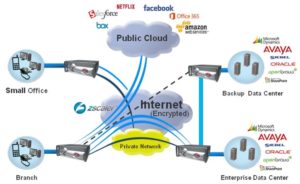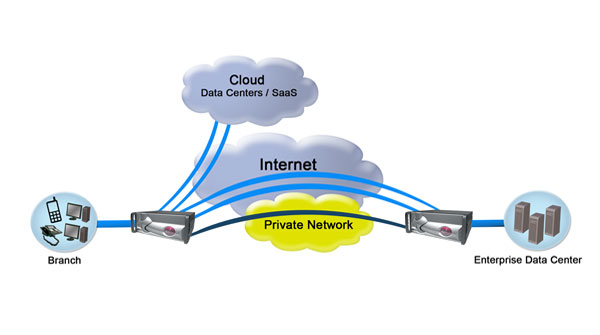WAN Edge and SD-WAN, what you need to know
There are plenty of articles and information on the WAN Edge. Perhaps the question to ask is, so what? How does this affect today’s multi-line hybrid WAN? With research suggesting there will be 50 billion devices attached to the Internet in the next 3 to 5 years, how does the corporate network manage access to their applications and information stored, both on premise, in the cloud and from WAN edge devices?
Today’s corporate WAN’s are complex, and the top issues faced by IT management are still the security of data flowing across the network, managing access, the co-mingling of on premise and cloud-based applications, and reliable, high speed connectivity. Adding new WAN EDGE devices is simply adding new access and data flow challenges that require careful management. But who has extra IT staff for this? They key to success rests with the management of this data traffic.
WAN of Things
The WAN ‘edge’ is evolving into the new WAN of things. Remember IoT? WANoT could be how data is to be served to users, no matter where they are, and no matter what device they use. The question then changes to how to ensure secure, reliable access to applications and information no matter what the access route.
Data can be anywhere these days, applications too. It is the secure, reliable access to this data, the applications and information needed to be successful in today’s digital society.
WAN Edge devices have computational power
WAN Edge devices have evolved to where they now have computing power, meaning a major portion of data analysis and computational functions are being handled “at the edge”. For example, routers are WAN edge devices, as are switches, but so are weather sensors and satellite tracking devices in shipping. The proliferation of these “smart” devices with computational power can transform the business WAN, especially if the data from these devices becomes mission critical. Instead of a device sending data only, it is now able to compute and send results of that computational analysis back to the WAN. This data is then sent to a web property or reporting tool. The downside of all of this computational activity that it adds more traffic to the network.
Control and management of data flow is not new, but is certainly becoming more critical, especially with more and more devices attaching to networks. WAN traffic management is the key and IT administrators are seeking solutions that automate the management of this traffic.
So, what about “SD-WAN”? Surely this was the answer to the IT administrators desire for WAN traffic control and management? Well, it seems that since the advent of SD-WAN, many businesses have been trying to implement a solution that supposedly promises nirvana. But this has had mixed results at best. The problem is that SD-WAN means different things to different people. Some SD-WAN solutions are complex, some are off premise or cloud based, and some cannot deliver on the promise of true WAN traffic management.
What is True WAN Traffic Management?
Recent research with customers across the globe suggests that “true” WAN traffic management requires sophisticated software that can automatically manage any traffic type, on any type of link. Today , businesses want to customize their data traffic that results in secure, highly reliable data flow across the WAN, with limited, if any, administration oversight. This software must have the ability to customize HOW to direct this WAN traffic, especially if it has come from a WAN Edge device, using tools that can prioritize link usage with options to customize the flow. Requested options are, interface type, application signature, protocol, IP address or destination, port source or destination or a combination thereof. True traffic management must also have the ability to set thresholds, based on almost any criteria, allowing for complete customization of how this traffic is directed across the circuits.
Identification of WAN Edge devices then becomes much easier, and the traffic flowing to and from them, customized and optimized. Using this true traffic management, it does not matter what type of device it is, where it is located, or how it is connecting to the network. Providing seamless, secure, and reliable access is paramount as is ease of installation and management.
FatPipe Networks has been developing and providing WAN traffic solutions for over 20 years. With 13 seminal patents, over 182 technical claims, FatPipe is a leader in the industry for SD-WAN, WAN Edge solutions and true WAN traffic management.
FatPipe is continuously innovating and developing to meet customer demand. FatPipe’s Software-Defined WAN (SD-WAN) and SDN traffic management solutions lead the industry with a security module that is FIPS 140-2 certified. With a rich, complete suite of software to customize application traffic on premise or in the cloud, as well as for remote users and offices, FatPipe offers true WAN traffic management. Cloud approved, FatPipe also supports any link type including Fiber, Copper, Wireless (3G:4G:5G LTE), and satellite.
Recently, FatPipe received a rating of 4.9 out of 5 by Gartner, and 100% of customers reviewed stated they would recommend FatPipe. The nearest competitor had 4.8 and 86% respectively.
If you are adding WAN edge devices, or are wanting to manage WAN traffic securely and cost effectively, you have to consider FatPipe Networks solutions.
Contact FatPipe today – 801-683-5656 or visit www.fatpipeinc.com








